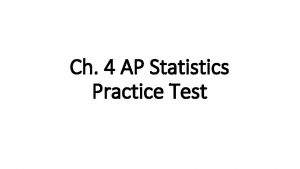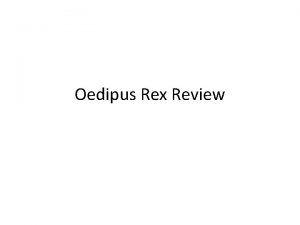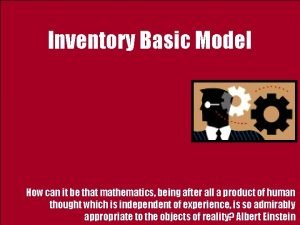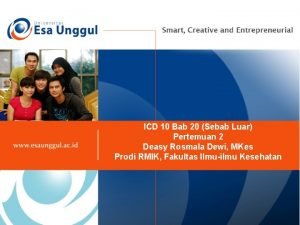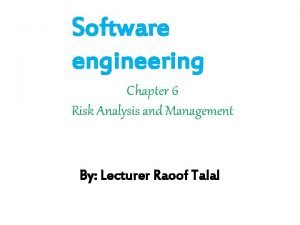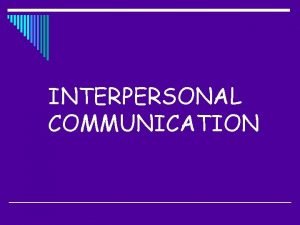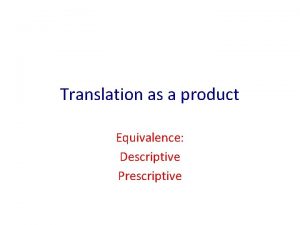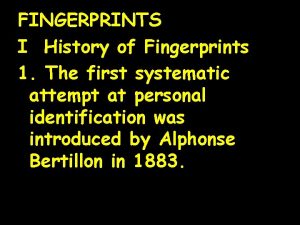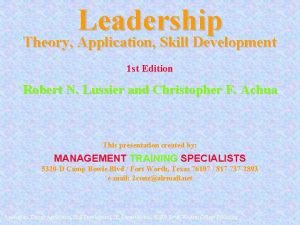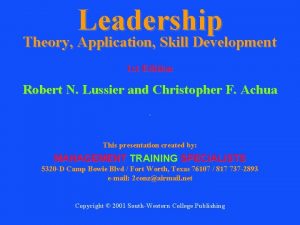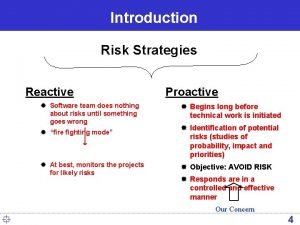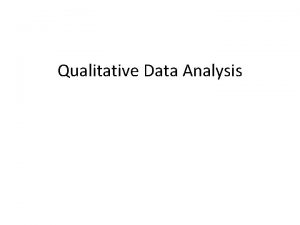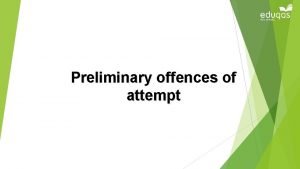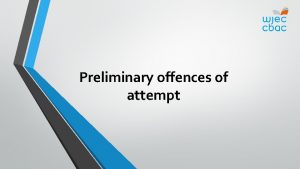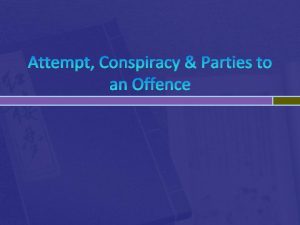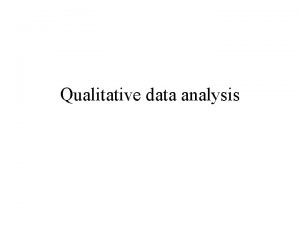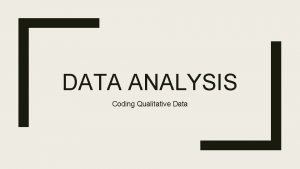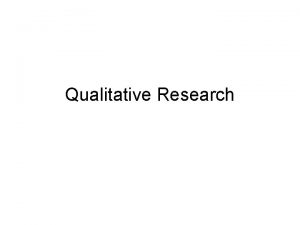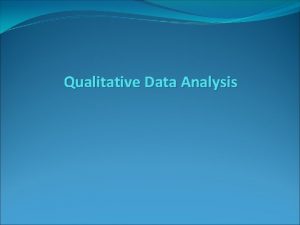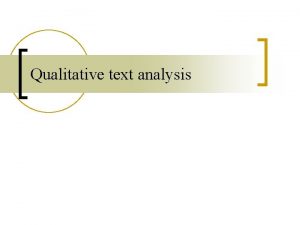Qualitative Data Analysis Qualitative data analysis An attempt

















- Slides: 17

Qualitative Data Analysis

Qualitative data analysis � An attempt to interpret the data that has been gathered and make meaning from it � The focus is on meaning not reduction � The aim is to reflect social complexity � There are many ways and approaches to analysis

Activity 1: Interpreting meaning Read the extract from Fever Pitch � List the content paragraph by paragraph � Summarise � What � Find the content in a single sentence are the main themes of the text? a sentence/section that seems to communicate something significant � Is there something going on here that isn’t actually said? � How do you respond to the text?

Some common principles � It is subjective and reflexive ◦ Subjective because the researcher is key ◦ Reflexive because the researcher revisits, re-examines and reconsiders emerging themes � It is transparent ◦ the process of the analysis should be visible � It is a systematic and rigorous process � It is an inductive and data led activity � It Involves a process of segmenting data and ordering it into meaningful units called codes

Coding � Deductive Coding ◦ Determining in advance themes to look for in the data � Inductive Coding ◦ The codes are determined as part of the analysis process and emerge from the analysis � In practice the two are often combined with some themes having been identified through reading research literature or through the data collection process and some identified at the point of analysis

The Grounded Approach � This is the most common form of inductive coding and is influenced by The Grounded Theory Approach (Glaser, Strauss and Corbin) � Meaning emerges from the data (inductive) � It is rigorous and time consuming � Creation of codes that classify the data for minute details (open coding) � This is iterative, emergent and in the initial stages highly fluid � Through analysis codes will be merged, split, clustered and refined (axial coding) � Memo writing facilitates emerging ideas and concepts abut the data to be captured � When no new codes emerge and all new data can be classified using existing codes the coding frame is said to be saturated

Some common concerns Most concerns stem from concerns about the subjectivity of the researcher, who � determines what is interesting in the data � may be being reductive � may over emphasise some themes while ignoring others � may ignore messiness in the data such as participant inconsistency or contradictions within the data

Activity 2: Interpreting meaning Read the coded version of the Fever Pitch extract � Do these codes reflect your earlier conclusions about the text? � What � Can codes might you have created? you see any links between codes? � What questions do they prompt in you about the meaning in the data?

An alternative approach � The most common forms of qualitative data are ◦ Interview transcripts ◦ Transcripts from focus groups ◦ Open-ended questions from questionnaires � The most common pattern to these is the question and answer format whereby the responses are shaped by the questions the researcher asks and these questions can shape the analysis. An alternative approach is to illicit a narrative response

Why collect narrative data? � To help us think creatively about the sort of data we collect � To consider how an actor orders and tells their experiences � To consider meanings and motives � To hand over control and direction to the participant � They can occur naturally – for example as part of a reply to a quest or prompt � They can be prepared for – asking participants to come with their st prepared � They can be part of an interview schedule – tell me about a time when…. .

Narrative analysis The most influential analytical approach to narrative data has come from the field of socio-linguistics: Labov’s Evaluation Model � Narratives have formal structural properties that can be identified and used to analyse the data: � Structure Question Abstract What was this about? Orientation Who? What? Where? When? Complication Then what happened? Evaluation So what? Result What finally happened? Coda Finishing the narrative

Narrative analysis Structure isn’t the only aspect that narrative analysts may look at, some also explore them in terms of function: - A moral tale? - A warning tale? - A tale of identity? - Entertainment? - News? - A tale with a lesson attached? - To help make sense of traumatic events? � What is its function for the teller? � Why is it being told this way? � What does the teller want us to hear?

Activity 3: Looking at narratives � Read the extract describing a student’s experience of anthropological fieldwork. � Analyse using different analytical techniques ◦ Inductive coding ◦ Narrative structure ◦ Narrative function � How useful is it to look at data in this way? � How might these methods of analysis help a researcher to make sense of the data and share the meaning with others?

Discourse Analysis � Discourse: ‘a particular way of talking about and understanding the world’ � Involves the examination of all types of verbal and textual materials spoken and written accounts, letters, journals, newspaper reports � Language is structured according to different patterns that people’s utterances follow when they take part in social life ◦ Academic discourse ◦ Advertising ◦ Your own discourse patterns in social and work settings � Discourse analysis explores these patterns in language and

Activity 4: Discourse Analysis Read through the two examples of texts and consider the following features: 1. The text: For each text identify and describe the key textual features: the grammar, the vocabulary, the presentational features. Who is the imagined reader? how is the institution represented? 2. The discourse: For each text identity different discourse patterns, does each text have a consistent pattern or are there different patterns in the text – what does the voice reveal about the speaker 3. Social practice: What conclusions could you draw about the discourses being drawn on in these texts? What do they tell us about the two universities? How could they be related to wider social theory to make more sense?

Critical Discourse Analysis • Is concerned with how social and political inequalities are reproduced in discursive practices – discourse is viewed as functioning ideologically • It is a critical approach and so has overt political aims to effect social change • Language use consists of three dimensions Language should beall empirically analysed its social of which need to bewithin covered in discourse context Text Discursive practice Social practice analysis: • The linguistic feature of the text • The processes relating to the production and consumption of the text • The wider social practice within which discourses exist

Qualitative analysis is not a final stage � It informs the design of the study � It is being shaped during data collection and data transcription � Throughout the analysis phase codes will be amended, redefined and new connections will be made � Analysis continues in the writing phase as you shape the meaning that has emerged in the coding and clustering
 Tonya wanted to estimate the average amount
Tonya wanted to estimate the average amount What does jocasta say she did with her baby
What does jocasta say she did with her baby 4500/800000
4500/800000 Kode icd 10 luka bakar
Kode icd 10 luka bakar Risk management planning in software engineering
Risk management planning in software engineering Systematic attempt to specify threats to the project plan
Systematic attempt to specify threats to the project plan Perbedaan attempt dan poging
Perbedaan attempt dan poging Communication does not happen in isolation
Communication does not happen in isolation Descriptive equivalence
Descriptive equivalence Fingerprint island ridge
Fingerprint island ridge Fcps uk
Fcps uk A collision attack is an attempt to
A collision attack is an attempt to Behavioral leadership theories attempt to explain
Behavioral leadership theories attempt to explain Behavioral leadership theories attempt to explain
Behavioral leadership theories attempt to explain Behavioral leadership theories attempt to explain
Behavioral leadership theories attempt to explain Systematic attempt to specify threats to project plan
Systematic attempt to specify threats to project plan Reactive risk strategies in software engineering
Reactive risk strategies in software engineering Money management international
Money management international
